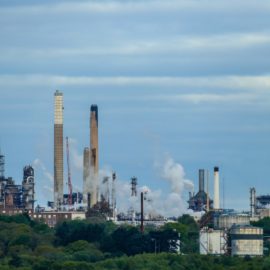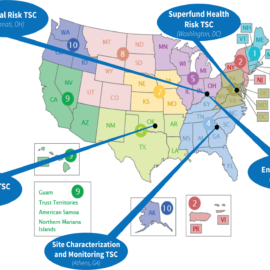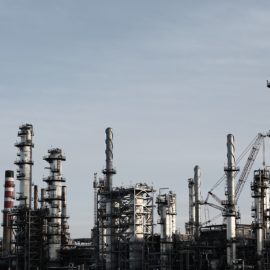
Look at all we are burning off with those flares! The question is are the doing what we thought.
A familiar feature on the horizon in some parts of south Louisiana, the flares that burn atop towers at chemical and other industrial operations serve as the safety valve of last resort. The huge flames destroy harmful pollutants that would otherwise be toxic to people or contribute to regional smog. With a purported 98% to 99% efficiency, they are critical cogs in the state permitting regime aimed at keeping air pollution to safe levels. But, at least for the last 10 years, the U.S. Environmental Protection Agency has concluded that these flares, for a variety of operational reasons, may not be as good at destroying all those pollutants as once believed, perhaps only 90% efficient on average.
nola.com
Environmentalists are sounding the alarm.
A collection of environmental groups in Texas, Pennsylvania, Indiana, Washington, D.C., and elsewhere say that difference in combustion efficiency can add up to a lot of extra pollution each year in Louisiana, Texas and other parts of the nation, especially for fence line communities. In just one sector, ethylene plants, improvements planned through EPA actions in 2020 will mean a reduction of tens of thousands of tons per year in toxic and smog producing pollution from just 102 flares across the nation. Now, under two new court agreements called consent decrees, the EPA will review over the next four and a half years flare rules for a whole new swath of petrochemical plants, plus those for petroleum and chemical storage tanks and marine loading tanks. “This is the first step for the agency to fix its old, flawed standards and better protect downwind communities from toxic air pollution from flares. EPA needs to overhaul its flare requirements to safeguard public health,” said Patton Dycus, a senior attorney for the Environmental Integrity Project.
The current rules go back to the 1980’s and a lot has changed since then.
Some of the existing flare rules, for instance, date from the mid-1980s, though federal law requires they have a fresh look every eight years. On Wednesday, a federal judge in Washington, D.C., agreed to accept two previously announced consent decrees between the EPA and the Environmental Integrity Project, some Louisiana environmental groups and others who have pressed for those and other changes. Under the deals, the EPA has made no commitment about what it will require, if anything. Dycus said the groups want the EPA to implement some of the same rules it has applied to oil refining in 2015 and ethylene production in 2020. Those include more intensive, minute-by-minute documentation of flare conditions and more precise control of the rate of gases headed to flares and of the heat of the flare. The hotter it is, the more completely chemicals are destroyed.
Of course industry says it will cost more.
One Louisiana industry group says if environmental groups get the kind of changes they are seeking, it would mean dramatic new expenses that could affect plants’ future plans. “It would be pretty costly to implement,” said Gregory Bowser, president and chief executive officer of the Louisiana Chemical Association. The group advocates for the state’s chemical industry and has 63 members who employ up to 30,000 people at 100 locations in the state.
The good to the community is greater than the cost to the industry.
The agreements settle separate lawsuits brought in 2020 and 2021 by EIP, the Louisiana groups and others. The suits were consolidated because they overlapped somewhat in what they were seeking. The agreement resulting from a lawsuit brought by Louisiana groups in 2021 will affect air pollution controls, not just flares, for an entire category of chemical plants. The category includes the Denka Performance Elastomer plant in St. John the Baptist Parish and 24 other operations governed by the same category or federal rules. Denka has been at the center of controversy after the EPA determined in 2010 that chloroprene, a major pollutant from the plant, was a carcinogen and has been a key driver in making the area around that operation have the worst air pollution cancer risk in the nation. The Denka category of plants also emits ethylene oxide, a chemical the EPA determined in 2016 was far more carcinogenic than previously believed.
This is where the flares come in.
The new EPA review focused on flares affects not only Denka and similar plants but also categories of plants that make resins, epoxies and non-nylon polyamides, according to the agreements. An exact tally of Louisiana operations that could see their flare operations affected wasn’t available from industry groups or regulators. But Bryan Johnston, air permits administrator for the state Department of Environmental Quality, said his best guess at this point is dozens. “It’s going to be a fair number of facilities,” Johnston said. Bowser said he believes any changes would affect more than a majority of LCA’s membership, which is still discussing how it will react to the consent decrees. Under the deals with the environmental groups, if the agency does call for changes, it must pursue the petrochemical plant rules first and propose them by March 31. Final rules would have to be issued within the following year, the decree says. Other changes to flares for storage tanks would be proposed no later than 2025 and be finalized no later than the end of 2026.
The EPA is looking more at the impact on the minority and non-White communities that live near the plants.
The EPA under President Joe Biden has stepped up its scrutiny of industrial facilities and how they affect fence-line communities that skew toward poor and minority residents, often at the urging of environmental and community groups though the courts and administrative appeals. Though several of those legal efforts started before Biden took office in January 2021, some groups say they are seeing a more favorable response from the current administration. In April, the agency agreed to open a civil rights investigation into DEQ after taking up petitions from the Louisiana Bucket Brigade, Rise St. James, Tulane Environmental Law Clinic, Earthjustice, Inclusive Louisiana and others, accusing the state agency of racism in its siting decisions. Anne Rolfes, who leads the Bucket Brigade, said she has her disagreements with some Biden administration initiatives, but it has the right instincts in trying to protect all people and recognize the historic burden born by African American communities. “It’s a mixed bag, but … oh, there’s no question this stuff is happening because of the Biden administration,” Rolfes said. “The problem is that unless we keep pushing, it is likely to have no meaning in Louisiana because” of DEQ’s leadership. Bowser, the LCA chief, said his membership has already been taking steps reduce air pollution. “The EPA seems to be ignoring that and has their own agenda,” he said.
It is good that the EPA is changing their focus to help those who need it.



